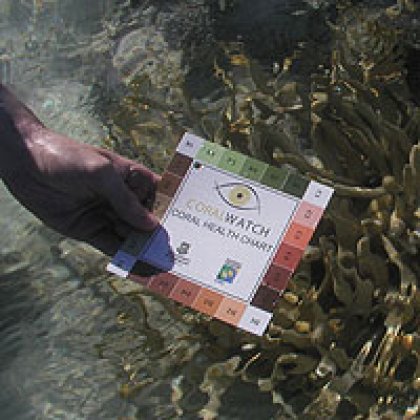
Scientists from The University of Queensland are asking tourists to help monitor the health of reefs worldwide.
Developed by UQ’s Professor Justin Marshall, CoralWatch is a program based around a cheap, simple and non-invasive method for the monitoring of coral bleaching, and assessment of coral health.
CoralWatch's development of the Coral Health Chart – a simple colour matching scheme – has provided a practical way for all members of the public to gather data.
Professor Marshall said the program worked particularly well on Heron Island, where the charts were used by tourists staying at the Voyages Heron Island Resort as well as scientists working at UQ’s recently rebuilt research station.
Located approximately 80km east of Gladstone, the Heron Reef is home to about 60 percent of the 1500 species of fish and about 72 percent of the coral species found on the Great Barrier Reef.
“Fortunately, on Heron Island there’s also a resort, so there are many non-scientists that come to the reef,” Professor Marshall said.
“They interact with researchers at the research station and learn more and go home and tell their folks at home about how wonderful reefs are.
“The combination of the research station and the resort is a tremendous bonus for understanding reefs worldwide.”
As well as a data gathering tool for scientists, the CoralWatch program aims to raise awareness about the health of reefs among the wider community.
“Engaging the community in terms of coral health is vital for their future. It really is the key to ensuring that reefs worldwide survive,” Professor Marshall said.
“While we as scientists know they’re declining and they may not be with us in 50 to 70 years’ time, that sad fact is still seeping through to members of the community.
“Because the Coral Health Chart is a simple colour matching scheme, anyone can use it – it’s just like matching paint to your wall at home.
“If a volunteer goes out with one of these and comes back with data which indicates that their backyard reef is in decline, that’s a very hard hitting point.”
Established in 2003, the CoralWatch program is now used by thousands of volunteers in more than 50 countries.
Professor Marshall said despite the large number of people using the charts, more feedback was required for the program to be used to its full potential.
“The CoralWatch system has a centralised website so anyone can give us back data from their forays on the reef,” he said.
“Several hundred groups have given us back data so we’re beginning to build up a worldwide picture.
“Certainly what we do need is a lot more data but, because this has only been running for a few years, we’re still hoping that our army of volunteers will give us more data back in the future.
“Although the CoralWatch scheme is, at its heart, a purely monitoring system, what we hope is that this will turn into a way of understanding the problems in more depth and, importantly, it will give people a focus on what is happening worldwide.”
For more information, please visit www.coralwatch.org.
High-resolution images to support this release are available at this link
Media: Professor Marshall (07 3365 1397, 0423 024 162, justin.marshall@uq.edu.au) or Penny Robinson at UQ Communications (07 3365 9723, penny.robinson@uq.edu.au)
.jpg)



